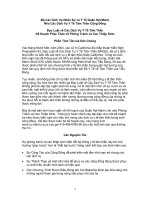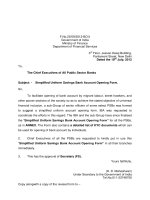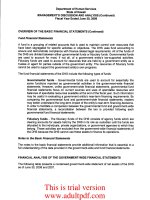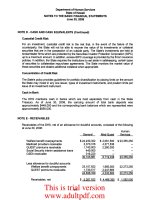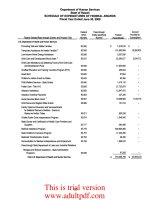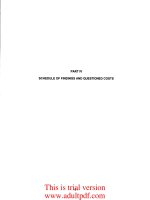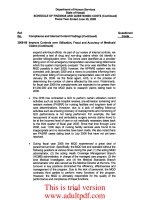WV Department of Education Office of Instructional Services
Bạn đang xem bản rút gọn của tài liệu. Xem và tải ngay bản đầy đủ của tài liệu tại đây (480.22 KB, 111 trang )
WV Department of Education
Office of Instructional Services
School Level
Professional Development Guide
2003-2004, First Edition
WV Department of Education
Division of Instructional and Student Services
Office of Instructional Services
Note: This cover for this publication was designed by WVDE Communications Office.
This page serves only as a means of identifying the document in computer files.
West Virginia Board of Education
2003-2004
Sandra M. Chapman, President
Barbara N. Fish, Vice President
Sheila M. Hamilton, Secretary
Delores W. Cook, Member
Priscilla M. Haden, Member
Burma Hatfield, Member
Lowell E. Johnson, Member
Paul J. Morris Member
Ronald B. Spencer, Member
J. Michael Mullen, Ex Officio
Chancellor
West Virginia Higher Education Policy Commission
David L. Stewart, Ex Officio
State Superintendent of Schools
“A mind stretched to a new idea, never goes back to its
original dimensions.” – Oliver Wendell Holmes
School Level
Professional Development Guide
Developed by:
Office of Instructional Services
Deborah Brown, Executive Director
Keith Butcher, Assistant Director
Document Authors
Karen Davies
Beverly Kingery
Richard Lawrence
Jan Stanley
Carla Williamson
Document Contributors
Rebecca Derenge
Murrel Hoover
Note: This cover for this publication was designed by WVDE Communications Office.
This page serves only as a means of identifying the document in computer files.
West Virginia Board of Education Professional Development
Goals
Through sustained, continuous, and school-embedded professional
development models, local school districts will be provided professional
development support and technical assistance in the following areas:
GOAL 1: All county school systems will implement the
components of a standards-based curriculum model built on the
WV Content Standards and Objectives. The model includes, but is
not limited to, the following components:
Mapping the curriculum
Development of instructional units and standards-based lessons
Identification of critical questions and enduring ideas
Alignment of instructional strategies, materials and resources
Use of performance descriptors, performance assessments, and rubrics
in the evaluation of student mastery
Establishment of benchmarks to determine student progress and
reteaching.
GOAL 2: All county school systems will improve student
achievement in reading and writing by implementing a researchbased approach to the teaching of the West Virginia Reading and
Language Arts Content Standards and Objectives.
All teachers will teach comprehension, vocabulary development, and
writing in their content areas.
Teachers with the primary responsibility of teaching reading and
writing will use research-based instructional strategies and consistent
approaches to literacy development.
Special educators will utilize research-based instructional design
appropriate to the exceptionality of the students served.
GOAL 3: All county school systems will improve student
achievement in mathematics by implementing a research-based
approach to the teaching the West Virginia Mathematics Content
Standards and Objectives.
School systems will give priority to addressing weaknesses in middle
level student performance.
GOAL 4: All county school systems will ensure all educators have
the technological skills necessary to effectively perform their
professional responsibilities and enhance student learning.
Teachers will use appropriate technology applications for teaching the
West Virginia Content Standards and Objectives.
i
Teachers will implement the Technology Content Standards and
Objectives.
School and district personnel will use technology-based data systems
to improve the instructional program and the teaching learning
process.
All personnel, as appropriate, will use technology management
applications to increase efficiency and effectiveness of district, school,
and classroom operations.
Table of Contents
1. School Level Professional Development Guide
Introduction .................................................................................. Page 1
National Staff Development Council (NSDC) Standards for Staff
Development......................................................................................... 3
Definition of High Quality Professional Development.............................4
Definition of Scientifically Based Research............................................5
Tips for Using the Guide.........................................................................6
2. Comprehensive Data Driven Needs
Introduction............................................................................................ 7
Professional Development Planning Process Flow Chart........................8
Target Professional Development Through Questioning & Examining Data
............................................................................................................... 9
What is Your Professional Development IQ?.........................................10
3. Long Range Planning for Professional Development
Introduction.......................................................................................... 19
Before the Planning ............................................................................. 20
Suggestions for Professional Development Plans.................................21
Guidelines For Effective Staff Development.........................................22
Defining An Effective Professional Development In Reading (PowerPoint®)
............................................................................................................. 27
Action Plan For Professional Development...........................................31
4. Formats and Models for Sustaining Professional Development
Introduction.......................................................................................... 37
A Research Based Staff Development Model Ensuring Implementation38
Some Avenues For Professional Development.....................................39
Professional Development Models........................................................40
Steps to Building a Sustained Professional Development Plan.............43
Sample: Professional Development Sample Model: K-3 Elementary Reading
44
Sample: Differentiated Instruction in the Middle Schools....................47
Sample: Planning for Change in High School Mathematics.................49
5. Monitoring and Evaluation
Introduction.......................................................................................... 59
Five Levels of Professional Development Evaluation............................60
Monitoring............................................................................................ 61
Evaluation............................................................................................ 62
Guiding Principles for Evaluating Staff Development...........................63
6. Leadership
Introduction ......................................................................................... 64
Professional Development Roles: Principal, Teacher Leaders..............65
ii
7. Funding
Introduction.......................................................................................... 66
Sources Of Funding.............................................................................. 69
Managing Complex Change.................................................................70
8. Bibliography.................................................................................71
iii
West Virginia Department of Education
School Level Professional Development Guide
SECTION 1
School Level Professional Development Guide
Introduction
Professional development is a form of adult learning. Yet, districts too
often forget that professional development must be concerned
primarily with student learning. Professional development in schools
has traditionally consisted of activities such as attending conferences
or working on curriculum during teacher workshop days. Dynamic
speakers and interesting workshops may have some value, but schools
and counties must help educators translate their learning into
instructional practices and student achievement.
Professional
development is not about what teachers want to know. Consider, for
example, a teacher who might want to expand his/her knowledge of
cooperative learning techniques. While the goal is valid, it becomes
relevant only when it is seen in a larger context, one that is focused on
student learning, driven by data, and nested within school level and
county level goals (Kelleher).
Professional development is the primary vehicle in efforts to bring
about needed change in student achievement.
Professional
development must include organizational development as well as
individual development (Sparks). It must be job embedded and
programmatic, and must be not only for teachers, but for everyone
who affects student learning. Perhaps most importantly, professional
developers are looking at the research on professional development in
education. They are examining what is known about the various forms
of professional development, not only for teachers, but for all those
involved in the educational process (Guskey). Since the goal of most
modern professional development efforts is improved performance by
the organization, staff, and ultimately students, (Sparks), information
on the measurement of student learning is an essential component of
planning professional development.
In defining student performance, it is imperative that educators are
introduced to the WHAT and HOW of instruction occurring in the
classroom. In order to understand this, the professional development
must focus first on pedagogy and methodology. For example, it would
first be logical to present professional development on the stages of
student writing development and the five step writing process before
professional development on interactive writing as a curriculum tool.
Therefore, professional development planners must determine if the
WHAT has solidly been introduced before planning the HOW of
professional development sessions.
1
West Virginia Department of Education
School Level Professional Development Guide
The National Staff Development Council (NSDC) has called for a shift in
the way we approach professional development. Its recommendations
include devoting 10% of the school budget and 25% of teacher time to
professional development. Thomas Guskey suggests that cost-benefit
analyses can be helpful in comparing the costs and relative
effectiveness of various professional development endeavors (Guskey,
2000). Such analyses will permit counties and schools to make the best
selection when considering different professional development
programs with similar goals.
Staff development standards provide direction for designing a
professional development experience that ensures educators will
acquire the necessary knowledge and skills. Professional development
must be data-driven, standards based, and job embedded.
The
National Staff Development Council revised the standards for
professional development in 2001. These revised standards reflect
what NSDC has learned about professional learning since the creation
of the original standards in 1995.
2
West Virginia Department of Education
School Level Professional Development Guide
National Staff Development Council Standards for Staff
Development
Context Standards
Staff development that improves the learning of all students:
Organizes adults into learning communities whose goals are aligned
with those of the school and district. (Learning Communities)
Requires skillful school and district leaders who guide continuous
instructional improvement. (Leadership)
Requires resources to support adult learning and collaboration.
(Resources)
Process Standards
Staff development that improves the learning of all students:
Uses disaggregated student data to determine adult learning
priorities, monitor progress, and help sustain continuous
improvement. (Data-Driven)
Uses multiple sources of information to guide improvement and
demonstrate its impact. (Evaluation)
Prepares educators to apply research to decision making.
(Research-Based)
Uses learning strategies appropriate to the intended goal. (Design)
Applies knowledge about human learning and change. (Learning)
Provides educators with the knowledge and skills to collaborate.
(Collaboration)
Content Standards
Staff development that improves the learning of all students:
Prepares educators to understand and appreciate all students,
create safe, orderly, and supportive learning environments, and
hold high expectations for their academic achievement. (Equity)
Deepens educators’ content knowledge, provides them with
research-based instructional strategies to assist students in meeting
rigorous academic standards, and prepares them to use various
types of classroom assessments appropriately. (Quality Teaching)
Provides educators with knowledge and skills to involve families and
other stakeholders appropriately. (Family Involvement)
“Professional development standards that make clear what high quality
professional development is, how to implement it, and how it should be
evaluated to help us design effective and powerful experiences that will
result in improved student achievement. … Standards provide the
foundation for building individual, school, and district professional
development plans that will stand the test of accountability.” - Agnes
3
West Virginia Department of Education
School Level Professional Development Guide
Crawford, Association for the Supervision of Curriculum Development
(ASCD)
4
West Virginia Department of Education
School Level Professional Development Guide
High Quality Professional Development
According to Title IX of No Child Left Behind (NCLB), professional
development includes activities that:
Improve and increase teachers’ academic knowledge;
Are an integral part of broad school wide and district wide
educational improvement plans;
Give teachers, principals and administrators the knowledge and
skills to provide students with the opportunity to meet challenging
state academic content standards and student academic
achievement standards;
Improve classroom management skills;
Are high quality, sustained, intensive and classroom-focused in
order to have a positive and lasting impact on classroom instruction
and the teacher’s performance in the classroom; and are not oneday or short-term workshops or conferences;
Support the recruiting, hiring and training of highly qualified
teachers, including teachers who became highly qualified through
state and local alternative routes to certification;
Advance teacher understanding of effective instructional strategies
that
1. are based on scientifically-based research and strategies for
improving student academic achievement or substantially
increasing the knowledge and teaching skills of teachers; and
2. are aligned with and directly related to state academic
content standards, student academic achievement standards
and assessments, and the curricula and programs tied to the
standards;
Are developed with extensive participation of teachers, principals,
parents and administrators of schools to be served under NCLB;
Are designed to give teachers of limited English proficient children,
and other teachers and instructional staff, the knowledge and skills
to provide instruction and appropriate language and academic
support services to those children, including the appropriate use of
curricula and assessments;
To the extent appropriate, provide training for teachers and
principals in how to use technology in the classroom to improve
teaching;
As a whole, are regularly evaluated for their impact on increased
teacher effectiveness and improved student academic achievement,
with the finds used to improve the quality of professional
development;
Provide instruction in methods of teaching special needs children;
5
West Virginia Department of Education
School Level Professional Development Guide
Include instruction in the use of data and assessments to inform and
instruct classroom practice; and
Include instruction in how school staff can work more effectively
with parents.
Other activities that might be included are partnerships with
institutions of higher education to establish school-based teacher
training programs; career ladder programs to help Title I
paraprofessionals become certified; and follow-up training to ensure
that teachers are able to implement what they have learned in the
classroom.
6
West Virginia Department of Education
School Level Professional Development Guide
Scientifically Based Research
As prescribed in NCLB the term “scientifically based research:”
1. Means research that involves the application of rigorous,
systematic, and objective procedures to obtain reliable and
valid knowledge relevant to education activities and
programs; and
2. Includes research that-
Employs systematic, empirical methods that draw
on observation or experiment;
Involves rigorous data analyses that are adequate
to test the stated hypotheses and justify the
general conclusions drawn;
Relies on measurements or observational methods
that provide reliable and valid data across
evaluators and observers, across multiple
measurements and observations, and across
studies by the same or different investigators;
Is evaluated using experimental or quasiexperimental designs in which individuals,
entities, programs, or activities are assigned to
different conditions and with appropriate controls
to evaluate the effects of the condition of interest,
with a preference for random-assignment
experiments, or other designs to the extent that
those designs contain within-condition or acrosscondition controls;
Ensures that experimental studies are presented
in sufficient detail and clarity to allow for
replication or, at a minimum, offer the opportunity
to build systematically on their findings; and
Has been accepted by a peer-reviewed journal or
approved by a panel of independent experts
through a comparably rigorous, objective, and
scientific review [Title IX, Part A, Section 9101(37)].
7
West Virginia Department of Education
School Level Professional Development Guide
Tips for Using This Guide
Here are some tips to best ensure a successful professional
development planning process:
1. Develop a planning team: Begin by developing a planning team
that includes a representation of the school’s grade configurations and
specialists (such as special education and music teachers). This team
could be derived from already established teams within the school
such as the local school improvement council (LSIC), the school
curriculum team, or committees formed through faculty senate.
2. Review this Planning Guide: The planning team should review
the School Level Professional Development Guide and discuss its use in
the process of planning professional development for the instructional
staff of the school. The team should determine which sections of the
plan would require entire staff participation, committee participation,
or individual participation.
3. Summarize the planning guide for the entire staff: This
Professional Development Guide should be used as a scheduled
professional development session. Within that session the planning
team should summarize the entire professional development guide
with the instructional staff and leadership of the school. The process
that the team will use in developing the professional development plan
should be a school collaborative effort.
4.
Strategically plan time to work through the planning
process: Ensure that there is an appropriate amount of time for the
team and the staff to develop and review the school’s professional
development plan. Some approaches to creating planning time as
suggested by Watts and Castle (1993) are:
Using one morning or afternoon a week for teacher development
and other improvement activities by using substitutes or
releasing students;
Purchasing teacher time by contracting substitutes or giving
compensation for weekends and summer work;
Providing common planning time for teachers working on the
same project;
Restructuring time by altering teacher schedules, teacher
responsibilities or the school day;
Making better use of available time and staff.
8
West Virginia Department of Education
School Level Professional Development Guide
An introduction is provided at the beginning of each section of the
guide.
9
West Virginia Department of Education
School Level Professional Development Guide
SECTION 2
Comprehensive Data Driven Needs Assessment
Introduction
The purpose of the needs assessment for professional development is
to determine the needs of the school’s teaching force in order to
enable all students to meet challenging state content and academic
achievement standards. This needs assessment does not stand alone.
It is the basis of comprehensive school planning and should guide the
development of school goals and direct professional development to
meet these goals. Gathering and analyzing school data from several
sources is the best way to identify trends and patterns in student
achievement and thus clarify school and student needs. For the
greatest impact in school improvement, professional development
must be based on the identified needs.
Four main categories of data should be included in the needs
assessment.
1. Student achievement data – In analyzing student achievement,
teachers need to determine specific deficiencies within content
areas. For example, if reading comprehension scores are low,
the staff must subset the data to determine the specific
comprehension skill in which the students are deficient. Teachers
must also view three to five years of data to be able to clearly
identify trends.
2. Demographic data – The purpose of collecting demographic data
is to gain a thorough understanding of the school’s population.
The goal is not to explain the demographics, but to examine how
these characteristics may affect opportunities for students to
learn.
3. Program data – The goal of reviewing program data is to examine
what is being taught and to whom.
This should include
curriculum sequence, course enrollment information, pupil
teacher ratios, teacher certifications for the areas they are
assigned to teach, the usage of parent/community volunteers,
graduation rates, post graduation follow-ups, etc.
4. Perception data – A review of this type of data will reveal how
teachers, students, and the community view the school and/or
district. The stakeholder’s view of the school’s services affects
all levels of planning. Perception data includes surveys on school
climate, student and teacher’s absenteeism and tardiness,
parent/teacher/student satisfaction surveys, and a review of
media coverage among others. The Professional Development
10
West Virginia Department of Education
School Level Professional Development Guide
IQ survey provided in this section provides a good introductory
activity for using this guide.
In conclusion, examining and analyzing school data is a powerful form
of professional development. Results of disaggregated data should
identify students’ needs, as well as teachers’ learning needs.
11
West Virginia Department of Education
School Level Professional Development Guide
THE PLANNING PROCESS
Step One:
Plan to Plan
Planning Participants
Program Designation
Vision,
Mission
Statement,
Goals
Needs
Assessment
Improvement
Objectives
Staff
Development
Technology
Conclusion
s
Monitorin
g
High Quality
Activities
Person(s)
Responsible
Time Line
Evaluation
Budget
Office of Education Performance Audits
Schools That Work
High
12
West Virginia Department of Education
School Level Professional Development Guide
Target Professional Development Through
Questioning & Examining Data
Questions to be answered in pre-planning:
Has the school met Adequate Yearly Progress (AYP)?
Has the school been identified for improvement?
Which indicators were not met?
o
o
o
o
Achievement
Participation rate
Attendance
Graduation rate
If all above indicators were met, identify other indicators that
support a need in this school.
Are all the school’s teachers highly qualified (certified in all
assigned teaching areas)?
What percentage of staff received high quality professional
development (see definition in the Introduction, Section 1) the
previous year?
The following data sources may be utilized to determine school
level professional development:
Student demographics (e.g. attendance, socio economic status,
graduation / drop out rate)
Student achievement (e.g. retention, grade distribution)
Instructional programs and curriculum
Assessment results
o
o
o
o
o
o
o
o
o
o
WESTEST
ACT
ACT PLAN
ACT EXPLORE
Scholastic Aptitude Test (SAT)
NAEP
Informal assessments (e.g. reading, math, Compass Learning)
Writing Assessment
Making Middle Grades Work Assessment
High Schools That Work Assessment
Percentage
of
teachers
receiving
quality
development.
School & classroom management procedures
Discipline reports
Technology access & usage
Parent & community involvement
Parent/teacher/student satisfaction surveys
Classroom walk through results
13
professional
West Virginia Department of Education
School Level Professional Development Guide
Continuous Improvement Monitoring Process (CIMP) results (From
Special Education)
Other applicable school documents
14
West Virginia Department of Education
School Level Professional Development Guide
What is Your Professional Development IQ?
1. According to the public, what is the most important characteristic for teachers to possess?
a. Ability to communicate with parents
b. Thoroughly educate students in subject area
c. Understanding how people learn
d. Well-trained and knowledgeable about how to teach effectively
2. Which strategy does the public believe has the greatest potential for improving schools?
a. Reduce class size
b. Recruit and retain better teachers
c. Require standardized tests for promotion
d. Give greater control to the local level
3. What percentage of the public supports school-financed professional
opportunities as a means of attracting and retaining public school teachers?
development
a. 90%
b. 85%
c. 70%
d. 55%
4. According to research, what school investment yields the greatest increase in student
achievement?
a. Lowering class size
b. Increasing teacher salaries
c. Increasing teacher experience
d. Increasing teacher education
5. According to the National Credibility Index, which of the following people is the most
believable when speaking out on public issues?
a. Member of the Armed Forces
b. Teacher
c. Community Activist
d. National Expert
6. According to research by Ron Ferguson, which factor constitutes 44% of the impact on
student learning?
a. Class size
b. Qualifications of teacher
c. Family involvement and support
d. Socio-economic status of family
7. What percentage of the public believes we should increase funding for programs to keep
teachers up to date?
a. 35%
b. 50%
c. 66%
d. 70%
15
West Virginia Department of Education
School Level Professional Development Guide
8. What percentage of teachers believe that professional development programs
“generally waste their time?”
a. 10.5%
b. 27.4%
c. 41.7%
d. 64.7%
9. Which of the following strategies did superintendents and principals identify as the
most effective for improving teacher quality?
a. Reducing class size
b. Increasing teacher salaries
c. Increasing professional development opportunities for teachers
d. Requiring secondary level teachers to major in the subjects they are teaching
10. According to the September 2000 Gallup Poll, what percentage of the public feels
that the strategy with the most promise for improving achievement is ensuring that
there is a qualified and competent teacher in every classroom?
a. 10%
b. 17%
c. 39%
d. 52%
11. Of the following, which aspect of teaching is most important to students?
a. Caring about students
b. Believing all children can learn
c. Knowing the subject areas
d. Maintaining discipline in the classroom
12.According to teachers, what is the number one reason for professional growth?
a. To
b. To
c. To
d. To
improve student achievement
improve teaching skills
network
advance one’s career
13. What percentage of teachers believe that weekly scheduled collaboration with
other teachers improves their classroom teaching?
a. 62%
b. 72%
c. 82%
d. 92%
14.What do principals believe is the most important role of a principal?
a. Maintaining discipline and safety
b. Creating a supportive environment for teaching and learning
c. Supporting parents’ involvement in their children’s education
d. Managing the school’s budget and obtaining additional funds
16
West Virginia Department of Education
School Level Professional Development Guide
15.Which strategy do principals believe is most effective for recruiting and retaining teachers?
a. Providing financial incentives
b. Providing mentoring and on-going support for new teachers
c. Involving teachers in the creation of policies that they will be implementing
d. Providing career growth opportunities
16.Which professional development activity do most teachers feel improves their teaching?
a. New methods of teaching
b. Integration of education technology in their grade or subject
c. In-depth study in the subject area of their main teaching assignment
d. Student performance assessment
17.Which of the following professional development activities did the most teachers participate
in during the last twelve months?
a. Regularly scheduled collaboration with other teachers
b. Networking with teachers outside their school
c. Individual or collaborative research
d. Common planning period for team teachers
18.What percentage of public school teachers believe that being mentored formally by another
teacher at least once a week improves their classroom teaching moderately or better?
a. 58%
b. 68%
c. 78%
d. 88%
19.According to the 2001 National Board of Certified Teachers Leadership Survey, what
percentage agrees that they are satisfied with the quantity and quality of on-going
professional development opportunities in their schools?
a. 70%
b. 60%
c. 50%
d. 40%
20.According to the Educational Testing Service’s 2000 Report, How Teaching Matters, all of the
following increase student outcomes in science except:
a. Major/minor in science/science education
b. Professional development in laboratory skills
c. Professional development in classroom management
d. Using frequent tests
e. Hands-on learning
NATIONAL STAFF DEVELOPMENT COUNCIL
PO Box 240, Oxford, OH 45056
17
